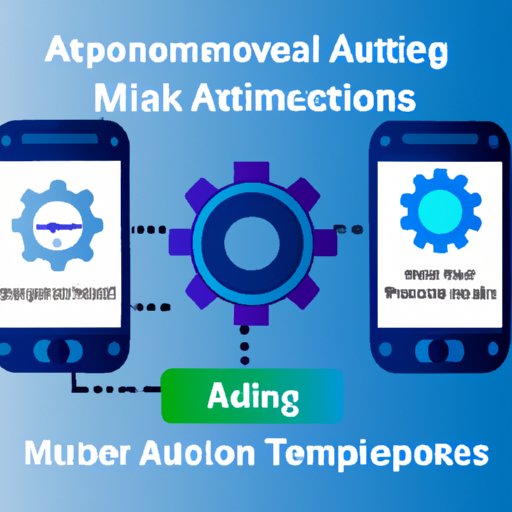Introduction
Automation testing for mobile apps is a process that involves the use of automated tools to test the functionality, usability, and performance of mobile applications. Automation testing helps ensure that an app meets the requirements of its users and is fit for purpose. In this article, we will explore what automation testing is, how it works, and some of the best practices for implementing it.
Understanding Automation Testing for Mobile Apps
Before we dive into automation testing, let’s first define what it is. Automation testing is the process of using specialized tools to automate the execution of test cases. It is used to quickly and efficiently test the functionality, usability, and performance of a mobile application. Automation testing can be used to check for bugs, identify areas of improvement, and ensure that the app meets its users’ needs.
There are several types of automation tests, including unit tests, integration tests, functional tests, acceptance tests, and performance tests. Each type of test has its own set of objectives and is used to validate different aspects of an app. For example, unit tests are used to test the individual components of an app, while integration tests are used to test how different components interact with each other.
A Guide to Automation Testing for Mobile Apps
So, how do you go about automating tests for your mobile app? Here’s a step-by-step guide on how to effectively automate tests for mobile apps:
Preparing to Automate Tests
The first step is to prepare for automating tests. This involves gathering all the necessary information, such as the device models and OS versions that need to be tested, the test scenarios that need to be covered, and the resources required to execute the tests. Once all the necessary information has been gathered, you can move on to creating automation test scripts.
Creating Automation Test Scripts
Once you have all the necessary information, you can begin creating the automation test scripts. An automation test script is a set of instructions that tell the test automation tool how to carry out the tests. The scripts should include details such as the steps to be followed, the expected results, and any conditions or parameters that need to be met. Once the scripts have been created, they must be reviewed and approved by the stakeholders before they can be executed.
Executing the Tests
Once the scripts have been reviewed and approved, they can be executed. This is done by running the scripts on the devices and platforms that need to be tested. The test automation tool will then execute the scripts and generate a report with the results. These results can then be analyzed to determine if there are any issues that need to be addressed.
Analyzing Results
The final step is to analyze the results of the automation tests. The results should be reviewed to identify any potential issues or improvements that need to be made. Once any issues have been identified, they should be addressed accordingly. This ensures that the app meets its users’ needs and is fit for purpose.

Automating Tests for Mobile Apps: What You Need to Know
When automating tests for mobile apps, there are several factors that you need to consider. These include the following:
Test Automation Software and Tools
In order to successfully automate tests for mobile apps, you will need to use a test automation tool. There are many different tools available, so you will need to choose one that meets your specific needs. Some popular tools include Appium, Calabash, Robotium, and Selendroid.
Test Data Preparation
Before executing any tests, you will need to prepare the test data. This includes setting up the test environment and creating the necessary test data. This data should be consistent and accurate, as it will be used to validate the results of the tests.
Test Environment Setup
The test environment is where the tests will be executed. It should be set up in such a way that it accurately reflects the real-world environment in which the app will be used. This includes setting up the necessary hardware, software, and networks.

How to Implement Automation Testing for Your Mobile App
Now that we understand the basics of automation testing, let’s look at how to implement it for your mobile app. Here are some tips to help you get started:
Determine Your Automation Goals
The first step is to determine your automation goals. What do you want to achieve by automating tests for your mobile app? Having a clear understanding of what you want to achieve will help you create an effective plan for automating tests.
Establish a Testing Framework
Once you have determined your automation goals, you can begin establishing a testing framework. This framework should include the processes and procedures that will be followed when automating tests. It should also include the tools and technologies that will be used, as well as the roles and responsibilities of the stakeholders involved.
Identify Potential Automated Tests
Next, you will need to identify which tests should be automated. This will involve analyzing the existing manual test cases and determining which ones would benefit from automation. Once you have identified the potential tests, you can begin developing automated test cases.
Develop Automated Test Cases
The next step is to develop automated test cases. This involves creating the test scripts that will be used to execute the tests. When developing the scripts, you should ensure that they are easy to read and understand, and that they accurately reflect the expected results.
Execute and Monitor Tests
Once the scripts have been developed, they can be executed. During this process, the tests should be monitored to ensure that they are running correctly. If any errors or issues are encountered, they should be addressed immediately.
Best Practices for Automation Testing for Mobile Apps
When automating tests for mobile apps, there are certain best practices that should be followed. These include the following:
Reuse Existing Test Cases
When possible, try to reuse existing test cases. This will save time and effort, as you won’t have to create new test cases from scratch. Reusing existing test cases will also help ensure that the tests are accurate and reliable.
Modularize Test Cases
Test cases should be modularized, meaning they should be broken down into smaller, more manageable pieces. This will make it easier to maintain and modify the tests in the future. It will also help ensure that the tests are efficient and reliable.
Utilize Test Automation Libraries
Using a test automation library can help simplify the process of automating tests. A test automation library contains pre-defined functions and classes that can be reused when creating test scripts. This will save time and effort, as you won’t have to write all the code from scratch.
Use Source Code Version Control
Using source code version control can help ensure that all changes to the test scripts are tracked and documented. This will help ensure that any issues or bugs can be quickly identified and resolved.

Automation Testing Strategies for Mobile Apps
When automating tests for mobile apps, there are several strategies that can be employed. These include the following:
Continuous Integration
Continuous integration (CI) is the process of regularly integrating new code into the existing codebase. This helps ensure that any new features or bug fixes are tested and deployed quickly and efficiently. CI can be used to automate tests for mobile apps, as it allows tests to be run after each code change.
Regression Testing
Regression testing is the process of verifying that a system or application still works after making changes. This helps ensure that any changes to the app don’t introduce new bugs or cause existing features to stop working. Automation testing can be used to quickly and efficiently run regression tests.
Performance Testing
Performance testing is used to measure the speed, responsiveness, and scalability of an app. Automation testing can be used to quickly and efficiently run performance tests to ensure that the app meets its performance requirements.
User Experience Testing
User experience testing is used to evaluate the usability and user-friendliness of an app. Automation testing can be used to quickly and efficiently run user experience tests to ensure that the app is easy to use and provides a good user experience.
Conclusion
Automation testing is a powerful tool that can be used to quickly and efficiently test the functionality, usability, and performance of mobile applications. By following the best practices outlined in this article, you can ensure that your app meets its users’ needs and is fit for purpose. With the right tools and strategies, automation testing can help you deliver high-quality apps in a timely manner.
(Note: Is this article not meeting your expectations? Do you have knowledge or insights to share? Unlock new opportunities and expand your reach by joining our authors team. Click Registration to join us and share your expertise with our readers.)
